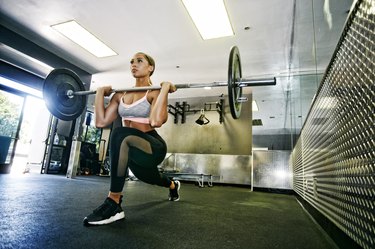
Long, sweaty cardio sessions seem like the way to go if you want to lose weight. And while cardio plays a role in shedding body fat, strength training is also a crucial aspect of any workout routine that supports weight loss long-term.
Not just any old strength training will do, though. For best weight-loss results, your strength training routine should focus mostly on compound exercises (ones that target multiple muscles).
Video of the Day
Video of the Day
Whether you're new to the weight room or spend your gym time doing biceps curl after biceps curl, here's everything you need to know about compound exercises — and why they're an absolute must if you're strength training to lose body fat.
Why Strength Train for Fat Loss?
If you're not sold on strength training as a worthwhile weight-loss tactic, know this: "Strength training supports fat loss because muscle demands more blood flow and nutrients than fat," says Grayson Wickham, DPT, CSCS, founder of the mobility and flexibility platform Movement Vault.
This increased blood flow requires energy (think calories), so the more muscle you have, the more calories you burn every day, even when you're not exercising. In fact, "at rest, one pound of muscle burns three times as many calories as one pound of fat," says David Chesworth, CPT, director of fitness at Hilton Head Health.
Research published in the July/August 2012 issue of Current Sports Medicine Reports backs Chesworth up, finding that just 10 weeks of resistance training can increase resting metabolic rate by about seven percent. (Seven percent may not sound like much, but that 2012 research ultimately found that it correlated to almost four pounds of pure fat loss.)
What Are Compound Exercises, Exactly?
To make strength training most effective for weight loss, your gym time should consist primarily of compound exercises.
"Compound exercises involve multiple joints and muscle groups," Wickham says. Take squats, for example. "In a squat, your hip, knee and ankle joints all move — and your glutes, hamstrings, quads and calf muscles all work," Wickham says. Other popular compound exercises include:
- Push-ups
- Pull-ups
- Deadlifts
- Overhead presses
- Lunges
The opposite of compound exercises are isolation exercises, in which you use primarily one joint and muscle group. Biceps curls, for example, involve just the elbow joint and biceps muscles.
Why Compound Exercises Better Support Fat Loss
Imagine the effort it takes to do a calf raise versus a weighted squat and you already know that compound exercises require more oomph to perform than isolation moves. But how exactly does that translate to greater fat-loss results? In a few ways.
When you perform exercises that involve multiple muscle groups and joints at once, you put greater strain on your nervous system, which has to coordinate your muscle activation and movement, and on your cardiovascular system, which has to deliver more blood to your working muscles, Chesworth says.
Because of this higher demand, compound exercises stimulate greater adaptations, meaning you get fitter faster. Another result of the high demand compound exercises put on your body? "You burn more calories," Wickham says.
Since you'll use more muscles and burn more calories doing a few sets of squats than a few sets of lateral raises, focusing your workouts on compound exercises means you'll get more bang for your buck in the gym, he says. More efficient workouts mean greater overall calorie burn — and less time needed to do it.
In addition to burning more calories in the short-term, "compound exercises have also been shown to increase strength and muscle hypertrophy (aka muscle mass) quicker than isolation exercises," Wickham says.
Remember what Chesworth said about muscle tissue burning more calories at rest than body fat? The more muscle you build with compound exercises, the more and more calories your body automatically burns through every day, Wickham says. Over time, this quicker metabolism makes a notable difference in your ability to shed body fat — and keep it off.
Read more: Your Ultimate Guide to Gaining Lean Muscle
How to Make the Most of Compound Exercises
Sold on the short- and long-term weight-loss benefits of compound exercises? Start by making time for at least two or three strength training sessions per week, says Chesworth.
From there, make sure your workouts focus on compound exercises. Specifically, deadlifts and squats — often considered the holy grails of compound exercises — have similarly epic impacts on the body, according to September 2019 research published in the Journal of Strength and Conditioning Research.
If you've got about an hour to spend on strength training, Wickham recommends focusing on one to three main compound moves. Start with three to four sets of six to 10 reps, resting for a minute or two between sets, to promote muscle growth.
Then you can sprinkle in a handful of isolation exercises. "You want to dedicate most of your energy to compound exercises and don't want to fatigue your muscles before performing them," Wickham says.
Once you've got your moves nailed down, just keep it consistent. "It takes roughly eight to 12 weeks to start achieving muscle adaptations and gains through resistance training," Chesworth says. Though you may not see changes in your waistline right away, your compound exercise efforts will pay off in the long run.